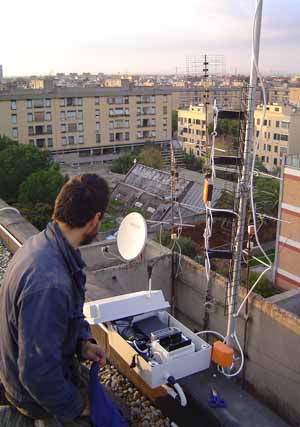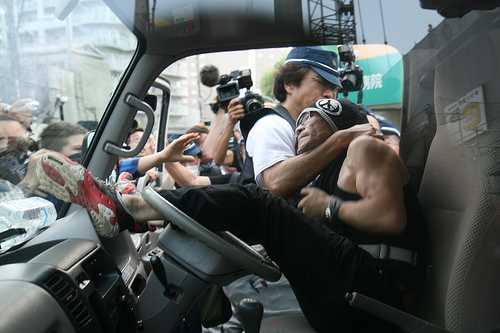Bifo in Osaka
Franco Berardi, better known as the Italian media theorist Bifo, was in Osaka, Japan last week as part of a tour that brought him to the protests against the G8 meeting in Hokkaido. He gave a talk on media activism at an event organized by Remo, a local media collective, where he discussed not only his own activity in Italy but posed some critical questions to the audience about the situation in Japan.
He began by playing a short documentary on Telestreet, a pirate television project organized around Italy that seeks to create self-media and challenge the existing media monopoly held by people like Silvio Berlusconi, the Italian media magnate turned prime minister. This project began in 2002 and spawned over 200 local stations that spread about cities in a cellular model: from their mixers to transmitters to transmitters.
For around 500 euros you can get set up with the basic infrastructure to broadcast: an aerial, cables, transmitter and amplifier. It’s possible to transmit from an ordinary roof-top TV aerial, though many of the TeleStreets use more expensive transmitters that allow them to broadcast further. On average they broadcast to around 1km, depending on the terrain. The better ones up to 3kms. Only a couple, such as TeleImmagini?, broadcast 24 hours a day. Some a few hours a day, others once a week, others sporadically. The TeleStreets broadcast mostly in the shadow of commercial stations, in areas where that stations’ signal it not receive clearly or at all.”

The stations and the support around them become micro-networks and their output can be accessed by any television set within range. Operators geared their new pirate studios towards relaying information about local organizations, struggles, factories, neighborhoods, news, music…
Public access with teeth? More like the public accessing itself, decrypting the codes that turn receivers into transmitters.
Telestreet and the depth of activity around it did not emerge from nowhere. Its operators are products of an experimental tradition with and against media and network technology connected deeply with the autonomist left in the country.
“While being an extremely recent practice, the street television movement draws on a history of experiments with independent media carried out since the seventies by the “creative wing” of the Italian autonomist movement. In particular, many of the figures involved in setting up Tele Orfeo in Bologna played a large part in the pirate radio station Radio Alice, whose launch in Bologna in was fueled by public disillusionment with the commercial media landscape that was just then beginning to take shape.
As the organizers suggested in a 1977 statement, communication was central to their radical struggles: “Capital’s program: communication within itself, neutralization of communication that is exterior to it. Its tactic: to disconnect communicative relationships from their objects, desire, power, truth… Communication is subversive: Power knows this… Our program: Subversion. Its means: Communication. Its content: Information. (Radio Alice, 1977) Broadcasting with a transmitter retrieved from an old army tank, Radio Alice chronicled the insurrectional events of 1977 in Bologna and its politics condemned by both the Italian state and the Italian Communist Party (the PCI).”
Against this uncontrolled communication and subversion, which bypassed the existing forms of media representation and had begun to overcome them, Bifo described a focused effort on behalf of the ruling media conglomerates during the 1980s and 90s to attack the pirate media by pushing advertising and commercial television onto the airwaves, “a political aggression against society” that aimed not only for media control but (more fundamentally) to break down social solidarity. To some degree this counter-offensive succeeded and radio and television were more and more in the hands of media barons.
Telestreet was brought together precisely to oppose this media paradigm with a broad auto-productive praxis. What effects did it have? Bifo disappointingly describes Telestreet as ‘a failure’. Not in the sense that the stations have ceased operation or been abandoned, no it is that Berlusconi the media king has won re-election in 2008 despite their efforts; to him this shows that they failed to go far enough. That they still have a long way to go.
This honesty struck me. How many are actually willing to admit the failure of a social movement, despite its contribution to real creative autonomy, in order to examine what a movement has achieved with no holds barred? It seems quite rare, especially on the radical left which too often prioritizes ‘movement’ above anything else. It is perhaps this lack of reflection, the peer pressure urge to always ‘look on the bright side’ which characterizes the aftermath of the G8 protests in Hokkaido, which Bifo’s visit coincided with. Coming nowhere near to the goal of ‘shutting down the summit’, the protests were largely characterized by complacent marches in the shadow of $280 million dollars sent on security and 21,000 police goons lined up against a mere 1,000 or so protesters.
From the beginning, the organizers formally negotiated with the police and paid the price: the marches passed nowhere near the meeting site and instead were forced into routes through the countryside at obscene distances, epitomized by a 22km daytime march through mountains and forest roads that only 100 people attended after the vast majority of participants denounced it and refused to attend. Despite the ‘good behavior’ of the organizers, four activists were nevertheless arrested for pathetically arbitrary reasons, such as having three people at a time on the sound system float (only two were allowed). Media coverage was mostly absent, even in ‘independent media’ despite the presence of hundreds of cameras. It is safe to say that the protests were not noticed at all, and even on their own limited terms were failures. Will there be people brave enough to admit this?


What success the G8 protests achieved was found in bringing together new interactions between Japanese anti-capitalists and internationals. Bifo’s talk was one of these, as well as the longer series of informationals and events held in major cities and Hokkaido. Having been to the marches, it seemed that Bifo had critiques of his own. After briefly introducing his activities with Telestreet and pirate radio, he turned the arrows the other direction. ‘I have had enough of talking about Italy and Europe…I want to know what goes on here.’ He noted the feeling of strong difference he felt from actions like Paris and Genova, the relation between the activists and the police, between the marchers and the city.
The straight lines. The people calmly drinking coffee while others are brutally arrested for the crime of making music. He moved to tear away at the usual expectations: ‘all of this, workers movements, student movements and so on are in the past’. We need a refoundation, to find resistance in phenomenon which express the emptiness of capitalist socialization, ‘the loneliness, the depression, the suicides’. But where is this to be found? Bifo points out the hikikomori (the pulled away), defined by
“the Japanese Ministry of Health, Labour and Welfare… as individuals who refuse to leave their parents’ house, and isolate themselves away from society in their homes for a period exceeding six months.[2] While the severity of the phenomenon varies depending on the individual, some youths remain in isolation for years, or in rare cases, decades. Often , hikikomori start out as school refusals, or tōkōkyohi (登校拒否) in Japanese.
While many people feel the pressure of the outside world, and may feel uncomfortable in public (or social anxiety), a hikikomori reacts by complete social withdrawal to avoid all outside pressure. In some cases, they may lock themselves into their bedroom or another room of their parent’s house for prolonged periods of time, sometimes measured in years. They usually have few, or no friends. A hikikomori’s days are characterized by long spells of sleeping, while their nighttime hours are often spent watching TV, extensively playing computer games, surfing the Internet, reading, trading the stock, Forex and other derivatives markets (i.e. stock future indices) or other non-social activities.”

Some in the audience seemed to react against his reference to this phenomenon. Perhaps because dependent Hikikomori are often of the middle or upper classes, true enough. Yet we are talking not only about the privileged few who can surfboard on their parents, but a phenomenon that wears away at everyone involved in the drudgery of working for a wage under conditions dictated by ‘social superiors’. The tendency towards withdrawal stems from a broad despair directed not only at the harsh hierarchies of everyday life, but life lived in the absence of any social safety net. The fetal position is easier than the fear of falling: just ask millions of Japanese workers who express their dissatisfaction in the workplace by feigning sickness, or making themselves sick.
Bifo does not intend to claim the hikikomori as a positive social subject, one that could herald a better world. No they are a genuine expression of the rage and helplessness felt at the old one, the complete inability to act, the total loss of subjectivity. They express the starting point of anti-capitalism in a society which finds capital invading everything: they are the roots rotted at the bottom of the cavity. In forcing his audience’s eyes away from the spectacular banners of protests and ‘great causes’, Bifo forces us to rethink where the wail of misery against this society is really produced. And perhaps he has also hinted at a plight of the left, which finds itself preferring to withdraw into inward circles. How did we get here? What is the way out?
To the audience’s amusement, Bifo closes by declaring ‘Hikikomori of the world unite!’, urging us to find ‘what is hidden in daily life’ and use that in ‘moving towards solidarity and subjectivity’.
JR
SUPPORT DATACIDE – ORDER A COPY, TAKE OUT A SUBSCRIPTION OR MAKE A DONATION – You can do all this through the form on the right of this web page (on mobile devices scroll down), or by clicking HERE for more information and payment options. THANKS!
Related Posts
 Over the past week and a half, an unprecedented political crackdown has been enacted in advance of a series of economic summits around the country. Despite this, the brave workers of Kamagasaki stood up against the stiff security environment in riots against the brutal beating of a day laborer over the past five days. The twin situations of repression and…
Over the past week and a half, an unprecedented political crackdown has been enacted in advance of a series of economic summits around the country. Despite this, the brave workers of Kamagasaki stood up against the stiff security environment in riots against the brutal beating of a day laborer over the past five days. The twin situations of repression and…- The crowd is the thing. You start with a meeting point and a time.There’s a another meeting going on. The G8 in Cologne. That sets the time. June 18th. The bankers and politicians have had long enough. A series of meetings; the Encuentros for Humanity and Against Neo-Liberalism called by the Zapatistas in Chiapas and in Spain; the meeting of…
- In Peckham a new city has been born. An arched bank of metal on struts covering a shallow stretched flight of steps for gospel singers and pissheads to air themselves on holds off the sky, turns it into barometric colour readings via floodlights, broken. An all slabs and no benches piazza; then the twin homes of the new heartland. Peckham…
